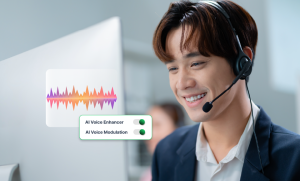Imagine a customer service call where both parties are fluent in English, yet the conversation stalls. Not because of a language barrier, but because of accent differences that create misunderstanding and frustration. Real-time accent conversion technology can eliminate this friction while preserving the personality of each speaker.
The system reshapes how global businesses communicate, offering a solution that goes far beyond traditional call center technologies. This post explores the AI architecture for transformation and why it matters for your business.
Challenge behind Accent Conversion Software
Real-time voice accent modifiers/convertors face challenges while enhancing someone’s accent while keeping everything else intact.
The AI in this technology must disentangle three distinct elements:
- the linguistic content (what’s being said),
- the speaker’s unique identity (their voice characteristics), and
- the accent features (how it’s being said)
The entire process must undergo within 200 milliseconds to maintain natural conversation flow.
Traditional voice technologies simply can’t meet this demand. They’re either too slow, sacrifice voice quality, or lose the emotional nuances that make human conversation meaningful.
How Real-time Accent Conversion Works?
Real-time accent conversion software operates through a sophisticated three-phase pipeline, each optimized for speed and quality.
Phase 1: Input Analysis and Feature Extraction
When someone speaks, the system first converts raw audio into a spectrogram. It is essentially a visual map of sound frequencies over time. Next, the AI performs what engineers refer to as “disentanglement.”
A speaker encoder extracts a unique voice signature, a digital fingerprint of characteristics like timbre and pitch range that make each voice distinctive. Simultaneously, a content encoder identifies what’s being said, stripped of accent markers. Think of it as separating the recipe from the chef’s cooking style while preserving the chef’s signature flair.
The system also receives input about the target accent, including General American English, British Received Pronunciation, or any other regional variation your business needs.
Phase 2: The Conversion Engine
Advanced neural networks take the extracted voice and content data and introduce the target accent’s pronunciation patterns, rhythm, and intonation.
Unlike older models that process speech sequentially (like typing one letter at a time), these systems generate multiple outputs simultaneously. This parallel processing enables real-time conversion.
Phase 3: Speech Generation
The final phase uses a neural vocoder to convert the modified acoustic data back into high-fidelity audio. Modern vocoders are specifically designed for ultra-low latency, producing natural-sounding speech that flows seamlessly in real-time conversations.
Why This Isn’t Just Voice Cloning or Text-to-Speech?
Business decision-makers often ask: “How is this different from voice cloning or text-to-speech?” Here are three distinct voice AI technologies that are often confused:
- Accent Harmonization (or Conversion): This technology works like a style transfer for speech. It makes words sound clearer by adjusting confusing phonemes and rhythm while strictly preserving the speaker’s unique voice identity, emotional tone, and vocal warmth.
- Voice Cloning: This system focuses on replacing the speaker entirely. It takes a voice and replaces it with a different voice (often a digital persona) but typically preserves the original speaker’s accent and what they said.
- Text-to-Speech (TTS): This is pure synthesis. It creates an entirely artificial voice and accent from written text, generating the speech from scratch.
Business Challenges and Opportunities
Real-time accent conversion technology, while powerful, still faces practical hurdles. The most significant is data scarcity. To build a well-performing system, you require large datasets of the same content spoken in multiple accents. This process is expensive and time-consuming to collect.
Background noise remains another challenge. Contact centers aren’t silent recording studios, and maintaining conversion quality in real-world conditions requires continuous innovation. Additionally, current systems typically work with broad accent categories rather than capturing fine-grained regional variations.
The Ethical Balance
Accent conversion can eliminate unconscious bias and improve customer satisfaction scores. However, it raises questions about cultural homogenization.
The technology also carries potential risks. The same systems that enable clearer communication could be misused for deceptive purposes, making authentication and transparency increasingly important.
Making the Decision
Real-time accent conversion represents more than incremental improvement in call center technology. It’s a fundamental shift in how global businesses communicate. The three-phase AI architecture—extraction, conversion, and generation—works seamlessly.
For decision-makers evaluating accent conversion software, the key questions aren’t just about technology. They’re about strategy: How does clearer communication impact your customer experience? What’s the value of expanding your talent pool? How do you balance technological capability with cultural sensitivity?
The companies that answer these questions thoughtfully, understanding both the sophisticated technology and the human implications, will lead the next generation of global business communication. Real-time voice accent modifiers connect people across the world.
Ready to hear the difference? Book a demo and witness our Accent Harmonizer in action.























